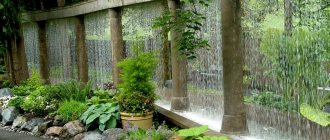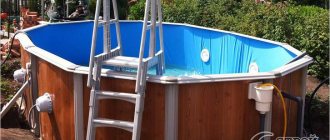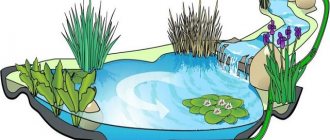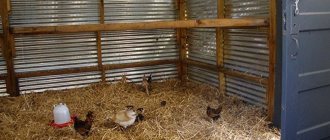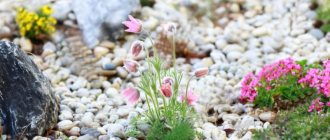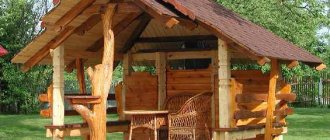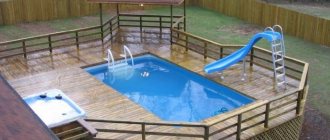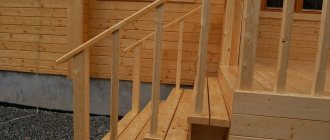History of origin
The modern structure of a dry stream is an interpretation of Japanese stone gardens. Every resident of the Land of the Rising Sun is very sensitive to nature. It has been elevated to the rank of a spiritual object and is part of philosophical teachings. Many, looking at beauty, learn to meditate and find answers to the questions of the universe. It was for these purposes that seven hundred years ago small stone gardens with dry streams began to be created.
The contemplator could observe their bed and imagine how it was about to begin to fill with water and turn into a full-flowing river. Such illusions, psychologists say, are very useful for restoring mental balance. A person, immersing himself in himself, has the opportunity to reflect on his life, analyze his actions and think through plans for the future. Over time, this idea of landscape design became widespread in the West. Now it is being actively developed in Russia.
Meditation object in a Japanese garden Source cruisebe.com
Main functions and advantages of the new element
Today, a dry stream in landscape design helps to clearly delineate different functional zones and mark the center of the garden. It can act as a well for drainage and be an element of the drainage system. Such a structure can become in demand where there are deep crevices in the areas into which melt water rushes in the spring. It is also advisable to make streams from stones where it is not possible to form a real reservoir on the site for some technical reason.
Many people, when they come to their dacha, simply do not want to service pumping equipment or clean such objects of silt. All this is very labor-intensive. In an artificial stream there is no need to constantly change the water; algae that cover the bottom of real reservoirs will not grow in it.
The object being described will not emit a musty smell; on the contrary, if you choose the right plants and plant them along its borders, it is not difficult to create flowering carpets fragrant with a pleasant, delicate aroma. Clouds of mosquitoes and midges will never gather around a dry stream; a dry stream in the country is a safe place for small children and animals.
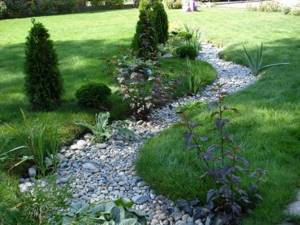
Blue stream on a green lawn Source gomelgazon.by
Such elements fit perfectly into the design of any suburban area. They favorably emphasize the advantages of the relief and the advantages of the chosen landscape concept. With their help, you can successfully hide drain holes or sewer hatches.
There are different types of execution. When choosing a specific object, it is easy to create unique elements and realize a variety of your fantasies, because there are a variety of materials and plants for this.
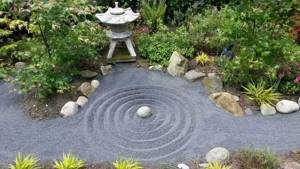
Dry lakes in the center of a picturesque garden Source fotovmire.ru
How to make a dry stream
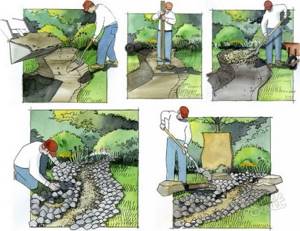
Using sand, the channel is marked. The outlined area is cleared of weeds and slightly deepened. It is advisable that the notch is not too deep, otherwise the stream will look unnatural. The next step is to lay a layer of sand and material that prevents the germination of weeds. It is best to cover the sand cushion with agrofibre.

It allows moisture to pass through well, but weeds do not penetrate through it. The coastline is laid out from large stones, and the interior space is filled with crushed stone, pebbles and small stones.
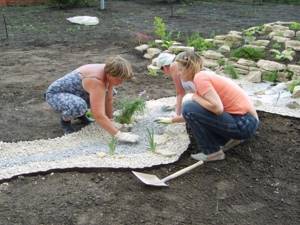
Bright blue shards of glass tiles, evenly scattered along the entire length of the riverbed, will help create the impression of water reflections.
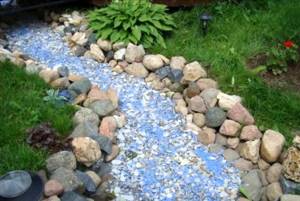
Vegetation is selected depending on the landscape. It is not recommended to use quickly growing shrubs, which in a few years will cover the entire composition with green mass.
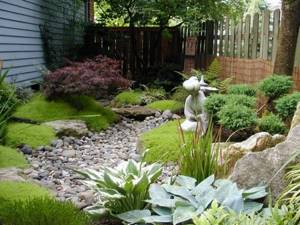
If the style of the site allows, single planted low-growing perennials are used in the design. The bulk of the plants used in dry creek landscaping are herbaceous ground cover planted in the spaces between the boulders.
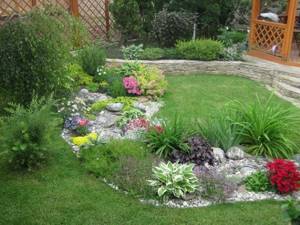
Sometimes a dry stream is arranged on a green, trimmed lawn. In this case, it attracts all the attention, so the selection of stones must be approached with greater care.
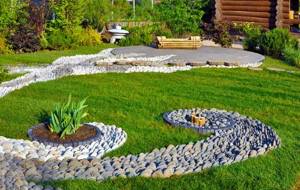
How to make a dry stream with your own hands - watch our video:
dizlandshafta
Where and how best to place streams without water
You can make a decorative stream anywhere: in the shade of plants, on the sunny side, on a hill, inside a depression. But in order for the described object to look organic, you need to use the following tips:
- When choosing the size of an artificial reservoir , it is necessary to take into account the area of the site. If it is large, you can create not only flowing rivers, but also large lakes.
- By creating shapes, you can visually change the space of the garden : on a long elongated area, a round lake will help to divide and make two different zones of the same shape. A winding stream will help visually lengthen a wide area.
- When determining the geometry of a dry reservoir , designers sometimes create one channel or several branches, using pebble stones they try to recreate streams of seething water hugging islands of rocks. Such techniques always look the most impressive.
- When indicating the shape of the landscape object being described, you need to remember how a real river spreads . If you change the width of the channel in different areas, you will be able to achieve the greatest naturalness. It is also necessary to take into account that the element being described has clear compositional structures. It consists of two elements: the source and the mouth.
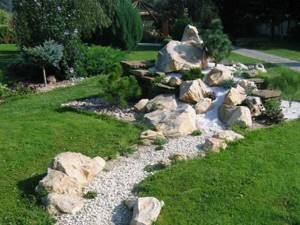
Experts recommend placing the source on a small hill. This technique will allow you to form the center of the future composition. It looks beautiful when an artificial stream originates from a rock or a hill of large stones of irregular shape or from a grotto, the creation of which can be felt by a human hand. When creating it, you can use the simplest techniques: making wells and various thresholds out of pebbles, reminiscent of a waterfall cliff.
The mouth is an imitation of the place where a stream flows into a small lake. It looks very beautiful when voluminous large plants (ferns, astilbes, hosts) are planted at the end of the artificial stream. With their help, the illusion is created that the water flow is hidden under them and goes somewhere into infinity.
There may be a dry stream on the site that goes under the fence. It is also capable of being the symbolic completion of a stream of stone. If there is a decorative fountain or a natural stream on the territory of the dacha, designers are willing to use it and combine the two objects. To do this, they use the same elements (similar types of finishes, the same plants). The overall composition looks very decorative.
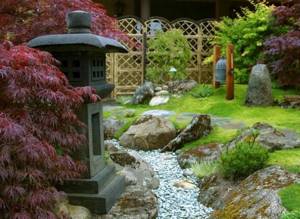
Complex relief, simple design Source thespruce.com
So, we make a stream in the country with our own hands
You will need:
large pump, water line and adapters, PVC putty, cement, tank 45 x 75 cm with lid, circular drills, waterproofing, geotextiles, foam water sealant, gravel, stone, decorative boulders, drill, hand tamper, level, 2- wheelbarrow without sides. (about materials for the construction of garden ponds and other reservoirs here)
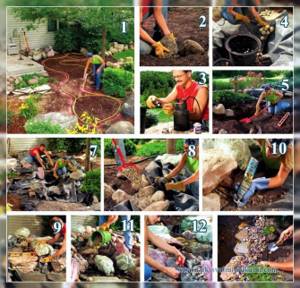
1. Mark the stream bed using a garden hose, then apply paint along it. Also mark the locations of the upper and lower reservoirs, waterfalls and large decorative boulders.
2. Dig a hole for the upper tank 0.6 m wider than the diameter of the tank and 15 cm deeper. To frame the edges of the tank and banks, place the first layer of stones with the flat side facing up so that the next layer is more stable. Using a rubber mallet, tamp down the soil and gravel around the stones. Dig a hole for the bottom tank. Place boulders along the edges of the top reservoir and the top of the stream that is above ground level.
3. We complete the work with the lower reservoir. Drill holes in the tank using drills of different sizes. Coat the hose adapter with putty and cement and insert it into the pump.
4. Place a layer of geotextile and waterproofing in the lower tank, extending the material 60 cm beyond the edges of the tank. After installing the pump tank, insert the pump into it, connect the water supply line and check that it reaches the upper tank. Connect the hose. Place the stone and cover the tank with a lid.
5. To create cascades at each height difference, dig out or, conversely, build a ledge to the height of the water drop. Starting at the bottom of the stream, dig a channel 0.6-1 m wide, 15-20 cm deep. Then dig shallow reservoirs under the waterfalls to slow the flow of water.
6. Line the banks with stones 15 cm high. Fill the gaps between the stones of the upper waterfalls with a mixture of soil and gravel. Then compact the soil around the top reservoir and bed. Align the waterfall ledges horizontally.
7. Start laying geotextiles and waterproofing at the bottom of the stream, starting from the lowest point, releasing the material 0.6 m beyond the riverbed. At the base of each waterfall, the material should sag a little so that the stones installed later do not break the stretched waterproofing. Place decorative rocks at the waterfalls, placing an additional piece of waterproofing under each heavy boulder.
8. To the shore
Main types
There is no clear breakdown into individual varieties. A flight of fancy plays a key role, but still experts identify three types that can be taken as the basis for execution.
- Winding pond . Its breakdown implies the presence of one channel, which narrows and widens in different areas, and somewhere goes around some islands. The creation of such an object involves the most accurate imitation of the movement of the river. This type of dry stream works best for large areas.
- Branched channel . This is a complex design. It must be carefully thought out at the planning stage of landscape design. It involves the creation of several streams, connecting at one point, and then diverging again in different directions. If climatic conditions suggest the presence of large amounts of precipitation, it is better to create such an object from pebbles: sandy rivers will quickly be washed away by streams of rain.
- Cascades and waterfalls . To create this version, you need to have a hill. You need to place the source on it, and then lead the main flow from it.
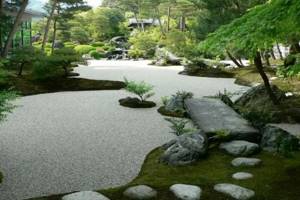
The simplicity of construction combined with excellent results, the absence of financial costs, and the absence of complex care explains why the popularity of such objects is steadily growing all over the world.
How to choose a place for a dry stream
Unfortunately, not everyone can boast of a huge suburban area. However, even if you only have a small area, this does not mean that it is impossible to organize a dry stream. Guided by simple rules, even a modest area can be decorated beautifully and stylishly.
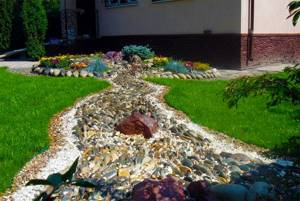
A dry stream can be built without taking into account the characteristics of the site: on a hill or in a lowland, on the sunny side or in the shade - any terrain conditions are suitable for it.
You can create a decorative channel almost anywhere: near a flower bed, in the shade of trees, next to a recreation area, and so on. A stream, the beginning of which is located on a natural hill or on a decent imitation of a rock, looks very impressive.
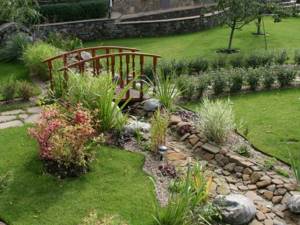
If a concrete jungle appears in your imagination, then you should purchase pebbles, crushed stone or gravel.
With a minimum of space, the stream is placed directly in the flowerbed. In this case, it is very important to choose the right plants to “frame” it. Avoid tall and massive ones, as against their background the “flow” will simply be lost, but low-growing and ground cover plants will highlight the source in a worthy way.
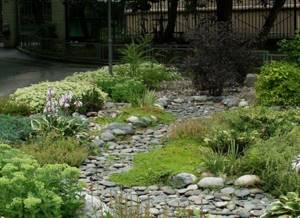
Don’t forget also about large stones that you can use to line the shores of a dry reservoir.
If there is a depression in the area, let the stream “run” right along it. Thus, an obvious disadvantage will become an advantage.
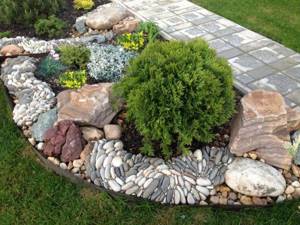
You should not make it straight - this way it will look more like a path rather than a flowing stream.
Another effective way to place a stream is to organize it on the lawn and include tall trees in the overall composition. In this case, you don’t even have to rack your brains about what other plants to place in the composition. With a minimum number of flowering species, the element looks very decent.
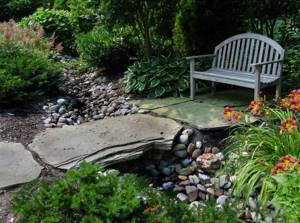
Despite the fact that the stream will be dry, it must contain all the attributes of the present: source and mouth.
Step by Step Guide to Creating a Dry Stream
The process of creating the described landscape design element is simple. Today many design companies and architectural bureaus offer to implement it. We invite you to read the step-by-step instructions that will help you avoid the most common mistakes and improve the quality of the finished result.
Beginning of work
First you need to draw up the contours of the future object. For these purposes, they take sand and use it to mark the area. To make a dry stream in the landscape design of a dacha look as natural as possible, it is important to avoid clear geometric lines.
Selecting the right material
River pebbles, marble chips or fine gravel are most suitable for simulating water surfaces. Today, such bases are available for sale in a variety of colors. Pebbles are blue-gray or beige, gravel is blue-green or blue, marble is silver or white. Objects that were created using different combinations look great.
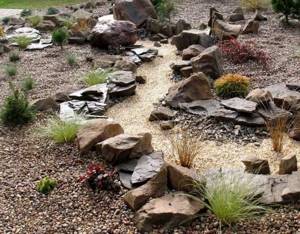
Dry watercourse made of pebbles and marble chips Source landshaftm.ru
There are professional tricks that you can use as a basis. Designers recommend using light-colored pebbles or crumbs to create rapids and shallows, a blue scattering of stones for deep pools, and gray pebbles for a “running channel.” If you move the pebbles with a rake, you can create slight uneven waves. Rocks of various shapes will help direct the movement of the artificial flow. Designers sometimes create “whirlwinds” around them. They are formed using smooth large pebbles laid out on edge.
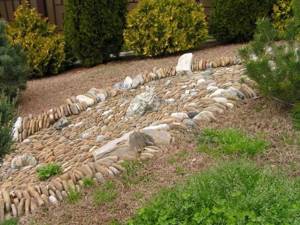
Stones laid out on edge Source sadogorodsad.ru
Pebbles and stones are painted before laying. If you choose moisture-resistant paint for these purposes, you will be able to create the effect of shimmering water; if you choose varnish, you will get a wet effect. When a spray bottle is used for this, the job becomes less labor intensive. The fused glass laid on top of the stone base of the stream looks very beautiful.
Construction of the pit
After the material has been purchased and delivered, the main scope of work begins. First of all, they create a stream bed. Along the lines marked out from the sand along the entire length of the stream, a trench 30 cm deep is dug. The base is carefully compacted, and geotextiles are laid on the bottom. Its use will prevent the germination of grass, as well as significantly simplify the process of caring for a new garden object. You should not fill the bottom with cement: this will immediately increase the estimate several times over and in the future will create problems with redevelopment of the site.
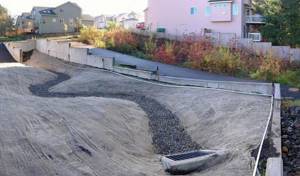
Trench under a dry stream Source furosemide.club
See also: Catalog of companies that specialize in landscape design services.
Laying stones
They begin to create a stream from the edges: the shoreline is formed with the help of large cobblestones. They will support the inner edges. The thresholds are also laid immediately. It is better to assemble them from flat stones placed on edge. It is advisable to use light-colored material for the indicated purposes. Afterwards, the free spaces are filled with small pebbles or stone chips.
Note! If the stream will be used as a drainage system, the stones must be secured with concrete mortar; geotextiles must not be laid at the bottom. Otherwise, the water will quickly wash away the man-made stream, or it will turn into a swamp puddle.
Arguments for a dry stream
You can lay the path of a dry stream in any part of the garden, no matter whether it is a hill or a depression, a sunny or shady place. In contrast, the bed of an artificial stream must have a slope.
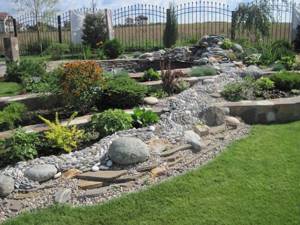
In addition, in an open place, water evaporates too quickly, which is why it needs to be constantly replenished. A dry stream is often used as part of a drainage system, and the cost of creating it is much reduced.
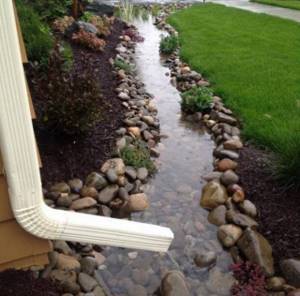
Another advantage is ease of maintenance: you do not need to monitor the cleanliness of the water and the condition of the bottom. Since there is no mechanical part (pumps and filters), there is no need to purchase and maintain it. Another important advantage is that any vegetation can be used in the design of a dry stream. Only moisture-loving plants can grow near ordinary bodies of water.
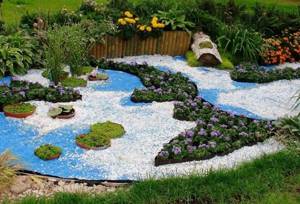
Video description
The video shows how to build the simplest dry stream with a wooden bridge:
Planting
Without green spaces, a man-made stream will not look complete. Therefore, rocky shores must be framed with plants. Designers recommend using those that are associated with the element of water for this purpose. This could be creeping tenacious, blue fescue, aubrietta, large-leaved forget-me-not. The banks are decorated with any low-growing shrubs. The lower tier is filled with flowering plants. The main thing is to compose the composition in such a way that, as it grows, it does not cover the stream itself.

Green frame of a dry stream Source pinterest.com
stream of flowers
Such compositions invariably become the center of the landscape. Here you can use your imagination to the fullest and create whatever you want. If you choose abundantly flowering plants with blue, blue or lilac inflorescences, you can create cool streams of water. Loberia, Portenschlag bellflower, gray fescue or lavender are best suited for these purposes.
White flowers (alyssium, carnation grass, cornflower), if planted near large stones, will allow the formation of light foam. The following photo will demonstrate what effect can be achieved.
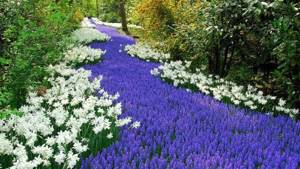
Flower streams - the center of landscape design Source desktopbackground.org
Selection of plants and their planting
When the outlines of the stream are finally formed, they begin to decorate it. Flowering plants, ornamental grasses, deciduous and coniferous plantings, and small shrubs are suitable for this.
Flowering plants
There is no need to use excessive floral abundance and a riot of colors to decorate a stream. Plants located in small groups would look appropriate near a decorative riverbed:
- Iris warty, Siberian;
- Ostrovsky's bow;
- phlox subulate;
- Arends astilbe;
- Przhevalsky's buzulnik;
- common primrose;
- hybrid daylily;
- clove-herb;
- Portenschlag's bell.
When choosing plantings, it is necessary to select specimens that are in harmony with each other in the shades of the flowers.
Photo: flowering plants for a dry stream
If you want to make a stream of water from flowers, replacing stones with them, use low-growing plants: lobelia, allisum, blue muscari.
Conifers
In large home areas, compact evergreen coniferous plants can decorate the stream.
The higher the size of the conifer, the more spacious the landscape area should be so as not to take away attention from the stream and look harmonious with it:
- creeping juniper;
- mountain pine, dwarf;
- green, blue spruce;
- thuja occidentalis, golden;
- dwarf fir, balsam, Korean.
Landscape designers use dwarf spruce and juniper species to create strict and laconic compositions, with plants arranged in groups or individually.
Photo: conifers for decorating a decorative riverbed
Evergreen plants are good because they look impressive at any time of the year and do not require special care after planting.
Ornamental grasses
In natural conditions, various types of grass grow near reservoirs. By planting such plants along the banks of a stream, you create the most realistic atmosphere for the entire composition:
- hybrid sedge Frosted Curls;
- gray fescue;
- sand grate;
- miscanthus chinensis;
- lake reed;
- Emperor.
Ornamental grasses are perennials that grow quickly and are attractive year-round.
Photo: types of ornamental grasses for landscape decoration
A variety of herbs look especially impressive both individually and in groups; they are used to decorate the banks and small islands located in the bed of a dry stream.
Deciduous ornamental plants
Particular beauty in the overall design of the banks of the artificial channel is brought by plants with catchy, expressive foliage - they grow in herbaceous bushes from 50 to 90–100 cm in diameter:
- hosta plantain, Liberty;
- bergenia cordifolia;
- creeping tenacious;
- brunera macrophylla.
Herbaceous perennials with decorative leaves delight with their beauty from spring to late autumn; they are not capricious and undemanding to care.
Photo: plants with decorative foliage
Plants with large leaves go well with flowers, herbs, and coniferous plantings. Many species can grow in conditions of lack of sunlight.
Ground cover plants
In nature, resilient plants grow on rocky, infertile soils that adapt to low amounts of moisture, lack or excess of sunlight, and sharp gusts of wind:
- bryozoan subulate;
- acrid sedum;
- felt peg;
- creeping thyme;
- Soapwort basilicofolia.
By decorating the banks of the stream with these types of plantings, you will achieve maximum resemblance to the natural environment.
Photo: ground cover plants for stream bank design
Ground cover species are undemanding in care, take root and grow well, sometimes it is necessary to limit their growth.
Video description
Ready-made ideas for creating streams of flowers in the video:
Additional decoration
An already finished object can be additionally decorated with wooden bridges and stone slabs thrown across the riverbed. Garden sculptures placed along the stream and street lanterns look picturesque. They add a touch of romance and allow you to create an atmosphere of special comfort in the evening.
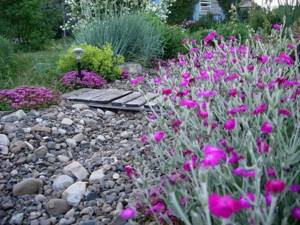
Wooden bridge over a dry stream Source landscapee.ru
Necessary care
Any element of landscape design requires maintenance. A stream made of stone is no exception. To maintain an attractive appearance, some work needs to be done. They are as follows.
- It is important to prevent excessive dryness of the soil along the entire length of the man-made stream. The accumulation of stones forms a special microclimate; in order for plants to live in it comfortably, it is necessary to water the stream.
- To prevent a new element of the landscape from becoming covered with a blanket of weeds , it is necessary to periodically pull out the weeds and free the plantings from dry grass and faded buds. It is important to regulate the height of planted plants and try to prevent them from growing too much.
- Experts recommend keeping an eye on insects and not allowing ants to build their houses under stones. They are the most common problem in man-made landscapes. Insects are gradually destroying man-made objects. They prefer to set up their homes under large boulders, so they need to be lifted and inspected systematically. If you don’t do this, very soon islands of loose sand will appear in the rock stream.
Water leak in a makeshift stream
The upper half of the stream with two waterfalls is located above ground, and the lower half of the 3-meter stream is in the ground. Over time, the soil, sand and plants along the edges of the waterproofing will take up water, which will subsequently penetrate beyond the edge of the insulation (proof of this is the wet soil around the tank). To prevent possible leakage, remove plants, soil and sand from the water's edge. Do not damage the waterproofing. Rock and gravel will not absorb water, but as a precaution, periodically remove sand and soil from the cracks between the rocks that surround the tank. If you want to keep your plants near water, you will have to add water to the tank more often to replenish the losses.
